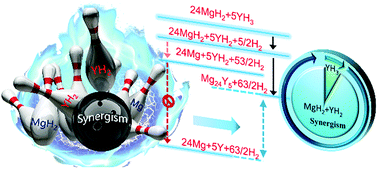Synergism induced exceptional capacity and complete reversibility in Mg–Y thin films: enabling next generation metal hydride electrodes†
Abstract
Much of the current research into metal hydride (MH) electrodes follows the principle that the materials should be composed of hydrogen-absorbing elements (A) and non-hydrogen-absorbing elements (B). This classical design principle, however, severely limits the potential capacities of the MH electrodes (typically <400 mA h g−1). Herein, we demonstrate a fundamentally new strategy to design high capacity MH electrodes without using B elements by inducing synergism in the dehydrogenation process. Mg24Y5 thin films, which are composed of two strong hydrogen-absorbing elements, achieve an exceptional electrochemical hydrogen storage capacity of ∼1500 mA h g−1 (5.6 wt%). All the absorbed hydrogen, including extremely stable H in YH2, can be reversibly desorbed through thermodynamic synergism. The present study provides enlightening insights to design high capacity MH electrodes and therefore enables the revival of Ni–MH batteries, and the emergence of next generation MH–air batteries.

- This article is part of the themed collection: 2018 Energy and Environmental Science HOT Articles


 Please wait while we load your content...
Please wait while we load your content...